

Pablo Ruiz Picasso (October 1881 – April 1973) was a Spanish painter, sculptor, printmaker and ceramicist who lived in France. He was one of the most influential artists of the 20th century. He was known for co-founding the Cubist movement, the invention of constructed sculpture, the co-invention of the collage, and for the wide variety of styles that he helped develop. Among his most famous works are the cubist 'Les Demoiselles d'Avignon' and the anti-war painting 'Guernica', a dramatic portrayal of the bombing of Guernica by German and Italian air forces during the Spanish Civil War.
Picasso showed extraordinary artistic talent as a youth, painting in a naturalistic manner. During the first decade of the 20th century, his style changed as he experimented with different techniques. Picasso began to explore more radical styles, and was described by critics as a leader of the modern art movement.
Picasso's work is often categorized into periods. The most well-known periods in his work are the Blue Period (1901–1904), the Rose Period (1904–1906), the African-influenced Period (1907–1909), and Cubism (1909–1919). His work in the mid-1920s could be described as Surrealism.
Very prolific throughout his long life, Picasso achieved renown and immense fortune for his revolutionary artistic accomplishments, and became one of the best-known figures in 20th-century art.
Cubism was about a reduction of forms to a few geometric shapes, showing multiple perspectives. Its flatness means neither the foreground or background are given greater importance. We perceive the world in multiple and changing ways; these paintings aim to reflect that.
Picasso was inspired by the work of George Suerat; the idea of multiple perspectives based on flat, geometric shapes was a new idea. His painting Les Demoiselles d’Avignon from 1907, depicting a group of variously dressed women, is considered the first Cubist painting.
Picasso is best known as a painter. He sometimes added sand to his paint to vary its texture. Picasso also used common house paint in many of his paintings. Much of his painting was done at night by artificial light.
Below are some samples of his most well-known works. Click on each to enlarge it; click again to shrink it.
|
Guernica is one of his best-known works, regarded by many art critics as the most moving and powerful anti-war painting in history.
The grey, black, and white painting, 3.5 m tall and 7.76 m across, portrays suffering from violence and chaos. Prominent are a gored horse, a bull, screaming women, a dead baby, a dismembered soldier, and flames.
|
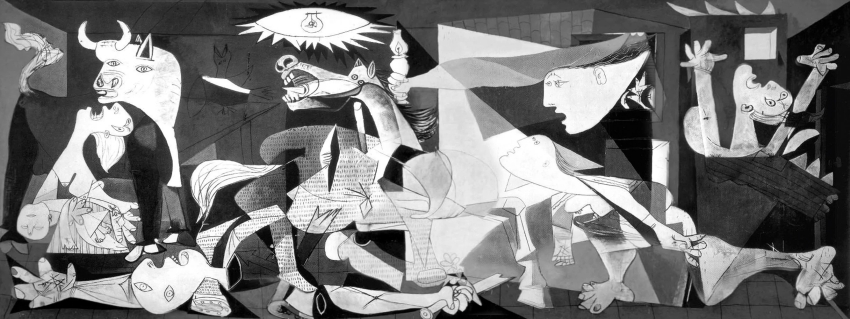
|
Picasso painted Guernica in response to the 1937 bombing of Guernica, a town in northern Spain that was bombed by Nazi Germany and Fascist Italy. The painting helped bring worldwide attention to the 1936-1939 Spanish Civil War.
Le Rêve (The Dream) is a 1932 oil painting that's 130 × 97 cm in size. It was created when Picasso was 50 years old, and portrays his 22-year-old mistress Marie-Thérèse Walter. Apparently it was painted in one afternoon.
This painting is one of his 'distorted depictions', with simplified outlines and contrasting colors. The erotic content of the painting is unmistakable.
In 2013 this painting was sold for $155 million, making it one of the most expensive paintings ever sold.
|
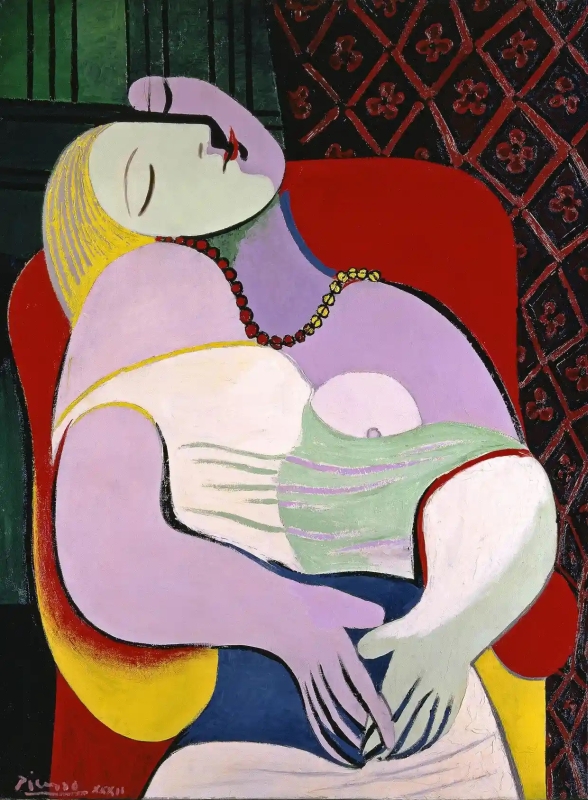
|
Buste de Femme au Chapeau (Girl with a Hat) is a linocut. Picasso experimented with linoleum by gouging a sheet of aluminum fused to a wooden block. The images produced were simple, bold, and this particular one is considered to be the greatest ever example of the technique.
A design is cut into the linoleum surface with a sharp knife or V-shaped chisel; the raised (uncarved) areas are a mirror image of the parts to be printed. The sheet is inked with a roller, and then pressed onto paper or fabric, often with a printing press. |
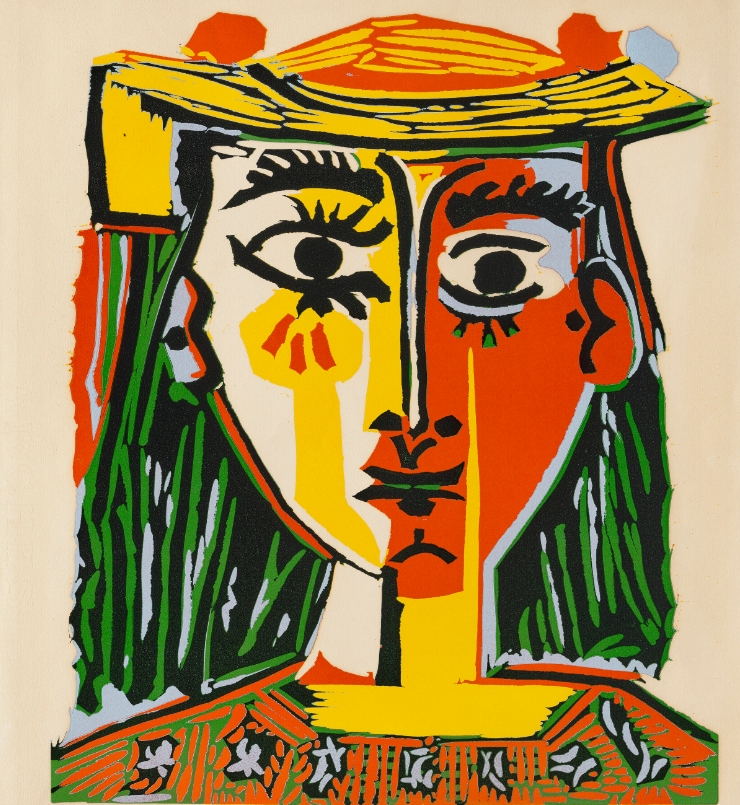
|
Picasso began working with linocuts in the 1950's; he innovated the process. Instead of using separate linoleum pieces for each colour, Picasso used just one block that could be printed and recut to produce lighter to darker hues. This method required a lot of planning and imagination, which Picasso clearly possessed.
Dora Maar au Chat (Dora Maar with Cat) depicts the artist's lover, seated on a chair with a small cat on her shoulders. The painting was sold for $95 million in 2006. This is one of many portraits of Dora Maar painted by Picasso over their nearly decade-long relationship.
Picasso fell in love with the 29-year-old Maar at the age of 55; he was drawn to Maar not only for her beauty, but also for her intellect and artistic nature. Maar assisted Picasso with his art, particularly during his creation of Guernica, which she documented with photographs.
|
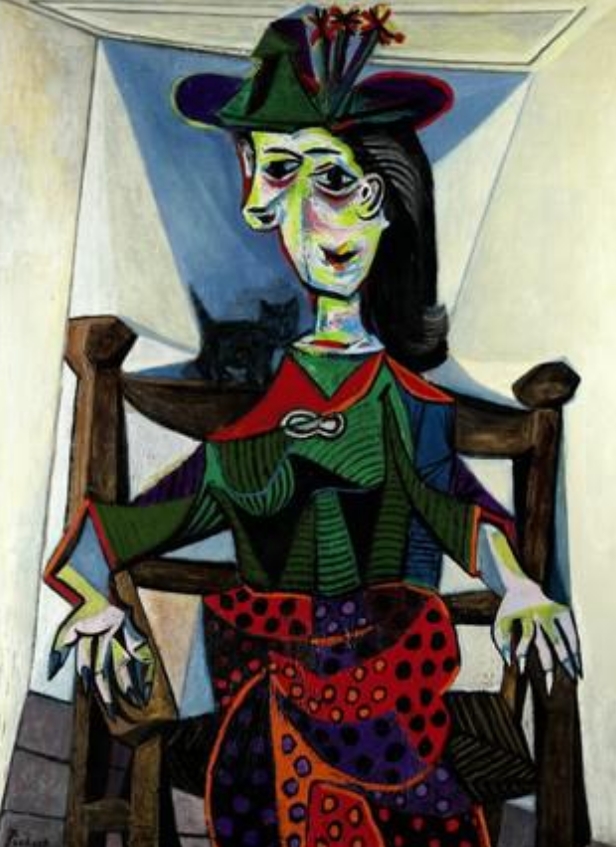
|
Picasso created Maar's portrait in the Cubist style. He used faceted planes and blocks of colour to sculpt her body. The shapes in the body are accentuated in black, while Maar's face is in white. The composition is a construction of shapes with vertical planes that contrast with the lines of the wooden floor in the background. Maar's face is presented from two angles, one half in profile with the eye looking straight at the viewer, and the other half of a full face.
This painting was made in 1941, at the beginning of World War II. When the Nazis occupied France, the tension between Maar and Picasso increased, resulting in Picasso portraying Maar in a much more abstract way, sometimes depicting her in tears. In this painting, Picasso aims to depict not only Dora's beauty, but also her temperament. He once described her as an "Afghan cat" in reference to her personality.
Figures at the Seaside is an example of Surrealism. A series of strange erotic beach scenes were painted in the summer of 1931 at Picasso's French Riviera vacation resort. Supposedly inspired by the 50-year-old painter's liaison with 19-year-old model, the grotesque nature of the form makes a moment of intimate contact into a crudity, probably more representative of his deteriorating relationship with his wife, Olga.
The praying mantis-like head of the two figures was a popular image with Surrealists because the perverse concept of the female insect eating her mate.
|
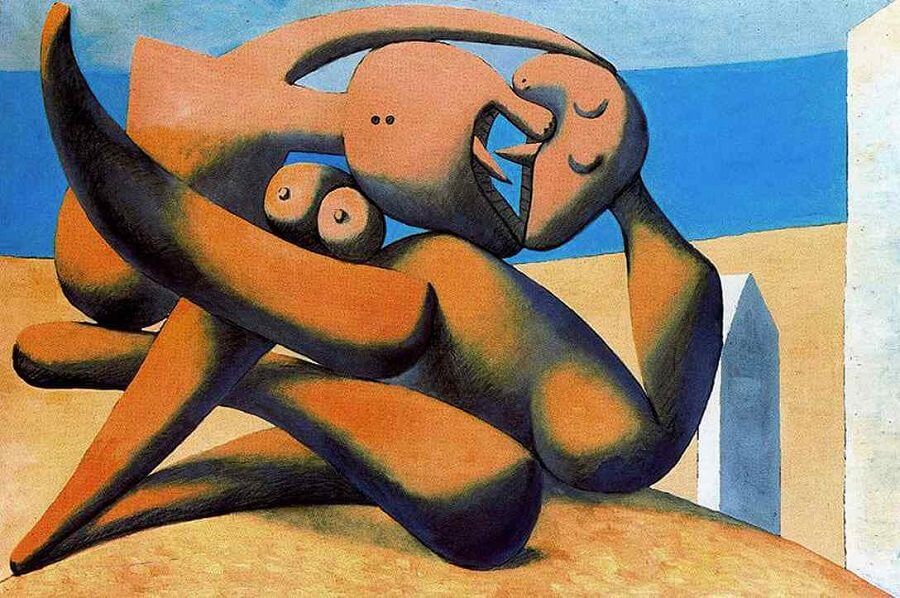
|
Les Demoiselles d'Avignon was painted in 1907 and is the most famous example of Cubism. 'Avignon' refers not to a city, but to the name of a street in Barcelona in a district known for prostitution.
In this painting, Picasso abandoned traditional art, using distortion and geometric forms in an new way. It also shows the influence of African art on Picasso.
This painting is a large work and took nine months to complete. He created hundreds of sketches to prepare for the final work.
The final painting was not well received by critics or the public.
|
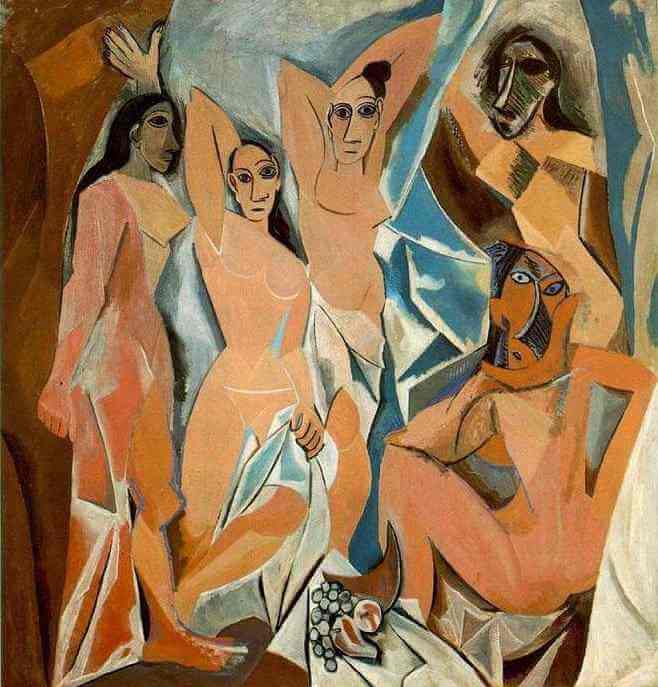
|
One reason "Les Demoiselles" is revolutionary is the omission of perspective. There is no vanishing point, nowhere for the eye to move beyond the women and their glances.
Picasso was definitely moved by the Tahitian journals of Paul Gauguin. Art experts attribute the primitivism of Gaughin's work as a significant influence on "Les Demoiselles d'Avignon."
The Old Guitarist is from Picasso's Blue Period when he was living in poverty. The painting is also notable for the ghostly presence of a mysterious image painted underneath.
It is likely that Picasso originally started painting a woman, who appears to possibly be seated, and in an upset mood. Not much of this image is visible except for her face and legs.The Old Guitarist was painted in 1903, just after the suicide of a close friend. The artist was sympathetic to the plight of the downtrodden and painted many canvases depicting the miseries of the poor, the ill, and those cast out of society.
|
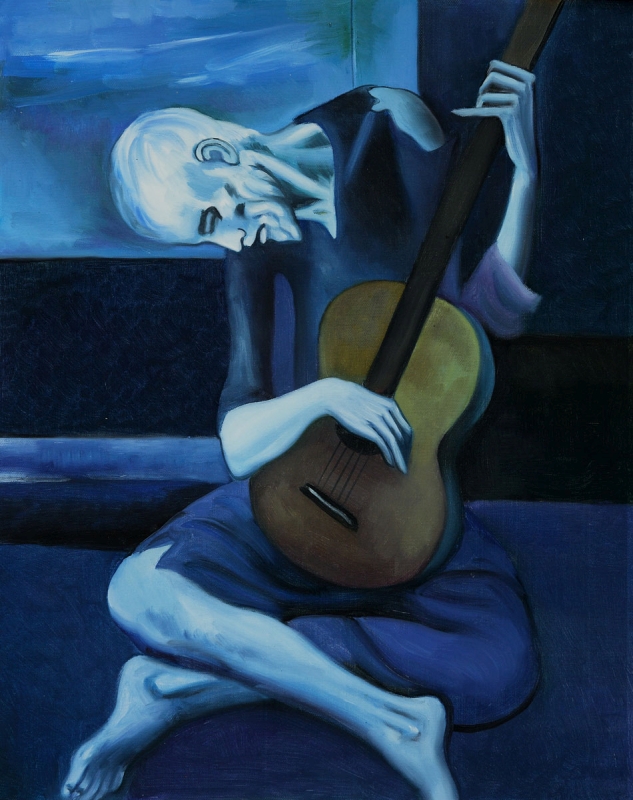
|
Garçon à la Pipe (Boy with a Pipe) was painted in 1905 when Picasso was 24 years old, and is part of his Rose Period. The painting depicts a Parisian boy holding a pipe in his left hand and wearing a garland or wreath of flowers.
Montmartre is where Picasso was living when he painted this. Some local people made a living in the entertainment industry, such as being clowns or acrobats. Picasso used many of them in his pictures. The boy may have been a model in his teen years who hung around Picasso's studio and volunteered to pose for the oil work.
In 2004 the painting was sold for $104,168,000 US.
|
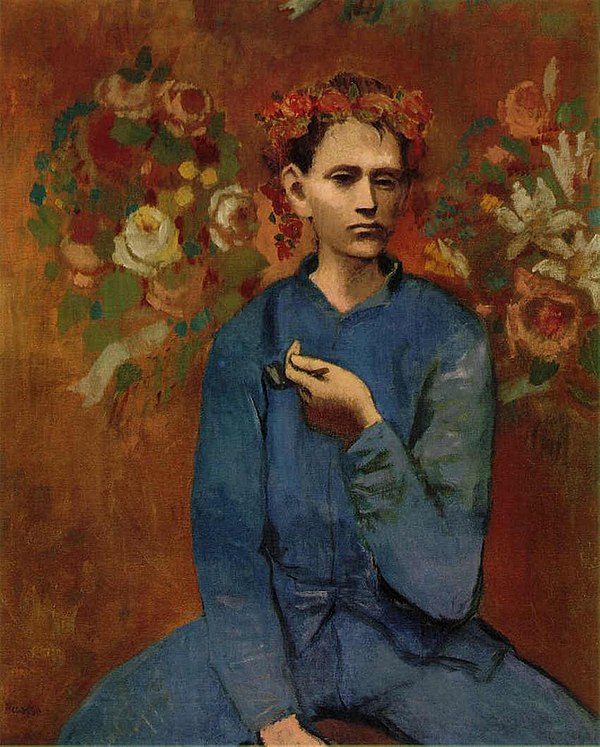
|
Jeune Fille Devant un Miroir (Girl Before a Mirror) was created in 1932. The painting is another portrait of Picasso's mistress Marie-Thérèse Walter, who is depicted standing in front of a mirror looking at her reflection.
The composition is a compicated arrangement of colours and lines, in sections, which makes it look like a stained-glass window. It was reworked many times by Picasso to produce a final dense and compressed image In this composition, Picasso used elements of Cubism to break apart the form of the woman. She is portrayed in a Surrealist style - from the side, yet her reflection depicts her from the front.
|
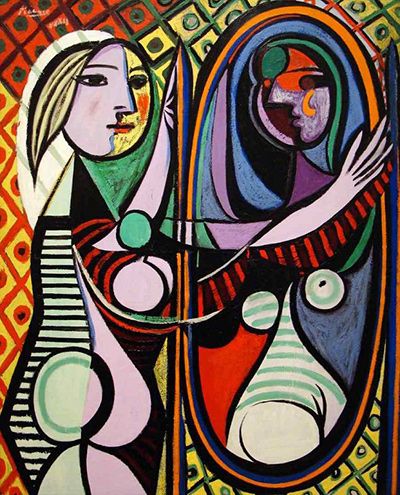
|
Resources
HTML, graphics & design by Bill Willis 2023
|










